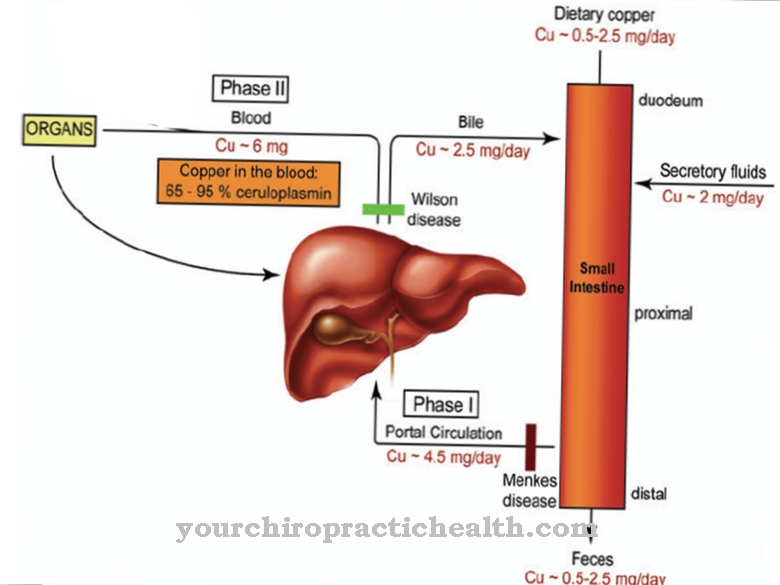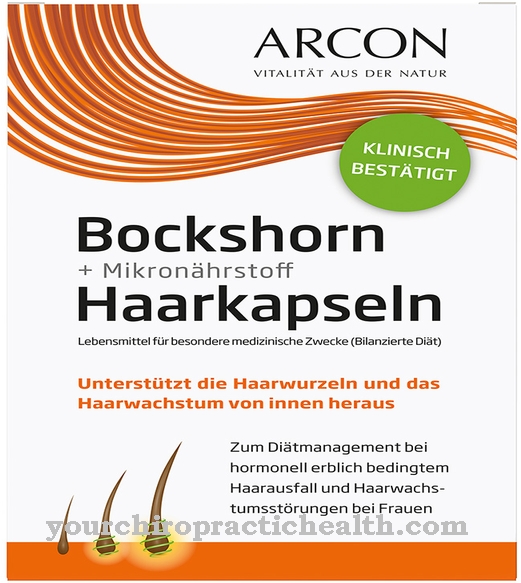Thyreoliberin is a releasing hormone synthesized in the hypothalamus, which by activating the secretion of the thyroid stimulating hormone TSH has an indirect influence on the synthesis of the thyroid hormones T3 and T4 and on the synthesis and release of prolactin in women.
Thyreoliberine is also involved as a neurotransmitter in the control of a large number of control circuits such as the circadian rhythm, thermoregulation, pain suppression and sympathetically controlled processes.
What is Thyreoliberin?
Thyreoliberine, too Thyrotropin Releasing Hormone (TRH), belongs to the chemical group of modified tripeptides, because it links three amino acids via peptide bonds and thus structurally corresponds to proteins.
The hormone - stimulated by sympathetic nerve impulses - is synthesized in the hypothalamus. In the anterior pituitary lobe (HVL), thyroid liberin has a stimulating effect on the production of the thyroid-stimulating hormone TSH, which in turn stimulates the synthesis of the thyroid hormones thyroxine T3 and its precursor T4 in the thyroid gland (glandula thyreoidea). However, thyroid liberin only responds to a limited extent to the negative feedback when there is an adequate supply of thyroid hormones, so that the synthesis of thyroid liberin is only insignificantly reduced even with a sufficient concentration of T3 and T4.
This already suggests that the control hormone has other important functions in the metabolism. In fact, it has been found that thyreoliberin, as a neurotransmitter in the central nervous system (CNS) in the brain, influences a great number of vegetatively and sympathetically controlled processes. It is known that Thyreoliberin z. B. is involved in thermoregulation and pain suppression as well as in circadian metabolic rhythms and controls heart rate and blood pressure via the vagus and sympathetic nerves and stimulates the secretion of certain glands such as the pancreas and others.
Function, effect & tasks
Thyreoliberin performs a variety of tasks and functions as a control hormone. It influences a wide range of metabolic processes and could almost be described as the global control hormone for the human body.
In the foreground is mostly its property as a thyrotropin releasing hormone, although this function only makes up the smaller part of the tasks and effects of thyroid liberin. As a releasing hormone, thyreoliberin also plays a role in the release of the female control hormone prolactin, which promotes the growth of the female breast and milk production during breastfeeding. Especially in dangerous situations or when there is an impending drop in body temperature, thyreoliberin causes the sympathetic nervous system to synthesize the thyroid-stimulating hormone TSH in the anterior lobe of the pituitary gland, so that a great many metabolic processes in the body are stimulated with energy consumption and corresponding heat generation.
The influence of thyreoliberin on the thyroxine balance occurs only indirectly via the activation of another control hormone. Even more important are the tasks and functions that thyreoliberin takes on as a control hormone in the CNS in the brain and for influencing endocrine and exocrine glands such as the pancreas. Particularly noteworthy is its involvement in thermoregulation, pain suppression and the control of circadian metabolic processes. In harmony with the stimulation of the sympathetic nervous system by stress hormones, thyroid liberin increases the heart rate and blood pressure and slows down the intake of food and fluids.
The control hormone supports sympathetic arousal through a large number of metabolic processes that serve to program the body in stressful situations for short-term high physical performance for flight or attack. In addition to the stress hormones adrenaline and noradrenaline, thyreoliberine has a central and global control function in the body's adjustment in acute and chronic stressful situations. Thyreoliberin, in conjunction with a large number of other control hormones and neurotransmitters, plays an important role in maintaining and controlling the global body metabolism, homeostasis.
Education, occurrence, properties & optimal values
Thyreoliberin - like numerous other control and releasing hormones - is synthesized in the hypothalamus. It consists of only three amino acids that are linked together by peptide bonds. The hormone is synthesized by cutting a tetrapeptide from the pro-thyreoliberine and converting it to thyreoliberine through several conversion stages. Pro-Thyreoliberin consists of a total of 280 amino acids.
The active thyreoliberine is also known as a modified tripeptide because it is protected from degradation by peptidases through minor modifications. After being synthesized in the hypothalamus, the hormone is transported via a special conduit system to the anterior pituitary gland, where it acts as a releasing hormone on the release hormone TSH to control the thyroxine balance. Since the biological half-life of thyreoliberin is only a few minutes, the concentration in the peripheral blood cannot be detected.
Instead, the so-called thyreoliberine test can be used to clarify to what extent the hormone influences the TSH level in the blood. The effectiveness of thyreoliberin on the many other metabolic processes depending on the status of the sympathetic nervous system cannot be measured or proven directly.
Diseases & Disorders
The most common problems in connection with the production of thyroid liberin is an overproduction of the hormone, which in turn leads to an increased release of the control hormone TSH with the effect that a so-called tertiary hyperthyroidism sets in, an overproduction of the thyroid hormone with all accompanying symptoms such as altered metabolism and Enlargement of the thyroid gland.
The overproduction of thyroid liberin can be caused by a pathological change in the hypothalamus or a tumor has formed in the body that synthesizes thyroid liberin itself and does not respond to any control loop, so that the release of the hormone is completely independent of other control hormones and does not stop immediately can be. Rare cases of underproduction are also known, which then lead to a deficiency in thyroid hormones. The apparent deficiency can also be caused by abnormal changes in the anterior pituitary gland (HVL) when the thyroid liberin in the HVL cannot exert its stimulating effect on the TSH control hormone.
















.jpg)
.jpg)



.jpg)






